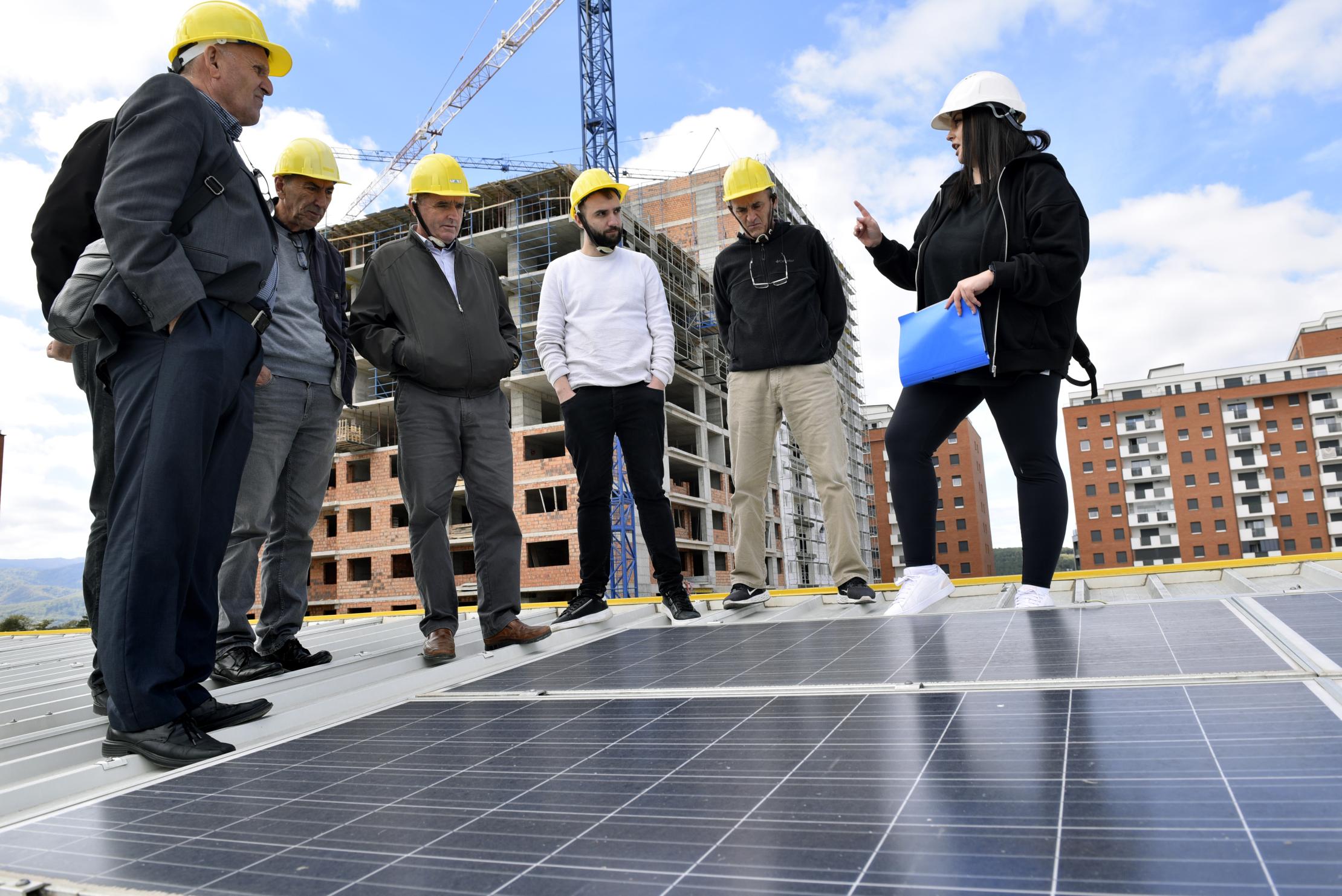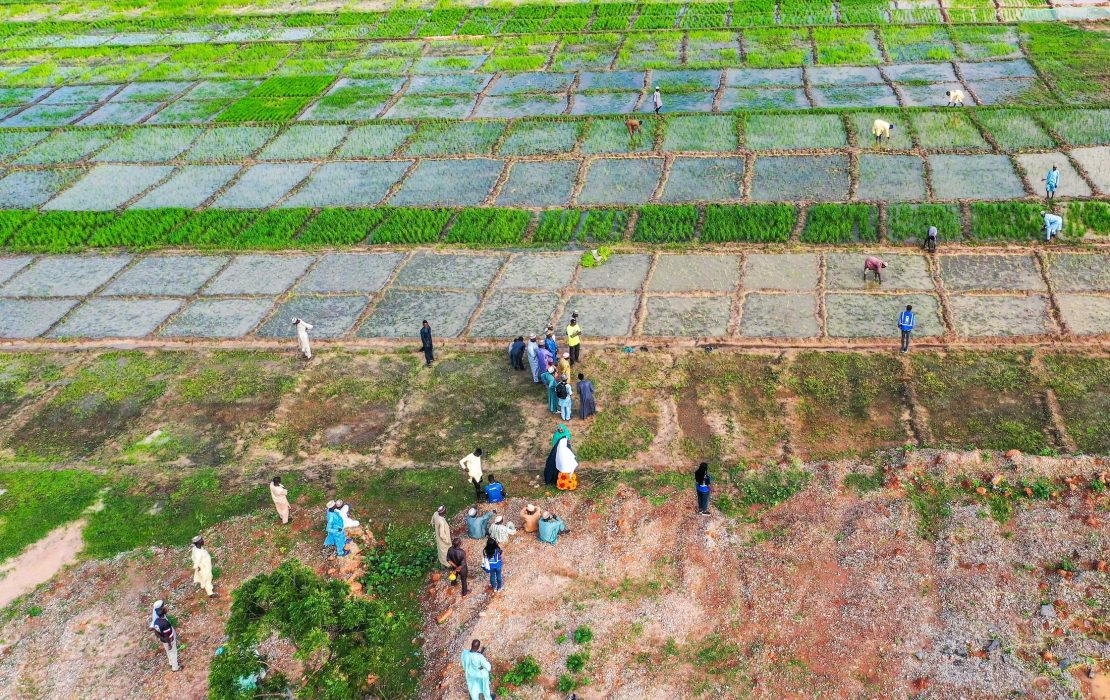
Foto: Mucyo Serge/PNUD Rwanda
Todos los días oímos hablar de los efectos del cambio climático. Tras experimentar el año más caluroso del que se tiene registro, somos conscientes de que el tiempo apremia para tomar medidas rápidas y decisivas que nos permitan reducir al máximo nuestras emisiones de gases de efecto invernadero.
Sin embargo, hay un punto importante en los esfuerzos por combatir el cambio climático que muchas veces pasa desapercibido: estas acciones pueden encarecer el costo de vida, provocar la supresión de puestos de trabajo y la pérdida de ingresos, o suponer amenazas para la seguridad energética y alimentaria; además, podrían ampliar la brecha socioeconómica entre los países desarrollados y aquellos en desarrollo.
Puede que hayas oído hablar sobre las manifestaciones generalizadas de agricultores en toda Europa contra las nuevas regulaciones medioambientales, que tienen por objeto reducir las emisiones de gases de efecto invernadero del sector agrícola. O tal vez te encuentras en un país rico en recursos como el litio y el cobalto, y te preocupe cómo afectará a tu comunidad la competencia global por obtenerlos. También es probable que hayas escuchado sobre el Mecanismo de Ajuste en Frontera por Carbono, iniciativa que entró en vigor en la Unión Europea el año pasado, y de las dudas que han planteado algunos de los países afectados. O bien, si ers un joven recién graduado con grandes ambiciones y estás reflexionando sobre las perspectivas del mercado laboral a futuro, es posible que te inquiete el hecho de que la carrera que has elegido quede obsoleta con el tiempo.
Independientemente de cuáles sean tus intereses o preocupaciones, el denominador común de todos estos casos es la necesidad de comprender los aspectos socioeconómicos de la acción climática desde el punto de vista de la equidad y la justicia. Los desafíos que enfrentamos en el ámbito climático no solo son de carácter ambiental, sino que también están profundamente entrelazados con cuestiones de equidad y justicia económica.
Si bien es evidente que necesitamos una acción climática contundente y ambiciosa para limitar el calentamiento global a 1,5 °C, también debemos comprender los efectos que supone esta transición y asegurarnos de minimizar las pérdidas y maximizar los beneficios. Este es el eje central de la transición justa: garantizar que todas las personas, las sociedades y los países se beneficien de las oportunidades que ofrece la creación de futuras economías acordes con el objetivo de 1,5 °C.
Pero ¿cómo podemos conseguirlo? He aquí cinco medidas que podemos adoptar para lograr una transición justa:
1.Integrar los principios de transición justa en los principales marcos climáticos.
Debemos garantizar que las Contribuciones Determinadas a Nivel Nacional (NDC, por sus siglas en inglés) y las estrategias de desarrollo a largo plazo con bajas emisiones (LT-LEDS) integren enfoques de transición justa.
La creación de un programa de trabajo dedicado a la transición justa (en inglés) en la 28.ª Conferencia de las Partes (COP28) de Dubái representó un avance fundamental en este ámbito. Las intensas deliberaciones que precedieron a la iniciativa resaltan su complejidad y la necesidad de una cooperación internacional con base en el principio de responsabilidades comunes pero diferenciadas.
2.Identificar hacia dónde avanzamos y qué estamos dejando atrás.
Las NDC y las estrategias de desarrollo a largo plazo con bajas emisiones son instrumentos climáticos clave del Acuerdo de París. Por ello, cada país debe definir su visión de un crecimiento económico ecológico y un desarrollo sostenible que se ajuste a sus circunstancias particulares y que se encamine hacia el objetivo de mantener la temperatura por debajo de 1,5 °C.
Este asunto cobra una mayor relevancia en la actualidad, ya que los países se están preparando para el próximo ciclo de revisión de sus NDC, cuya finalización está prevista para principios de 2025.
3. Comprender las repercusiones de la transición.
Es fundamental comprender cómo la transición ecológica influirá en las economías, las sociedades y los individuos, tanto de manera positiva como negativa.
Las repercusiones de la transición varían considerablemente según el país y la sociedad. Por ejemplo, la transición energética presenta desafíos particulares en África, sobre todo para los países muy endeudados, los hogares de renta baja y otros grupos vulnerables. Uno de los principales problemas es el riesgo de crear activos varados en el sector de los combustibles fósiles, lo que puede acarrear importantes pérdidas financieras para países e inversores. La situación es especialmente crítica para los países africanos productores de petróleo y gas, donde estos recursos constituyen una parte fundamental de la riqueza nacional y contribuyen a la estabilidad económica. La transición a las energías renovables, aunque es esencial por razones medioambientales y sanitarias, debe planificarse de manera que se mitiguen los problemas económicos y se favorezca el acceso a la energía.
En el caso de los pequeños Estados insulares en desarrollo, la competencia global por la transición energética plantea vulnerabilidades específicas (enlace en inglés) debido a la dependencia de los combustibles fósiles importados y las limitaciones de sus economías de escala. Como resultado, los costos energéticos aumentan, lo que afecta a sectores clave como el turismo. Este último, en particular, ha sufrido las consecuencias del impacto de la aviación y los gastos relacionados con la transición a combustibles con bajas emisiones de carbono.

Un grupo de trabajadores recibe capacitación para la instalación de paneles solares. Foto: Xhemail Sllovinja/PNUD Kosovo
En la agricultura y la silvicultura, el impulso a favor de las prácticas como la agricultura regenerativa, la reforestación y la forestación implica que los agricultores deban desarrollar nuevas habilidades y conocimientos. Para lograrlo, es fundamental ofrecerles formación, recursos económicos y apoyo para diversificar sus actividades y productos agrícolas. A ello se suma el aumento de los costos de producción debido a las normativas medioambientales sobre el uso de pesticidas y fertilizantes nocivos.
Además, la transición global hacia la descarbonización y las energías renovables ha generado una mayor demanda de litio y otros minerales esenciales, los cuales se encuentran principalmente en unos pocos países, en su mayoría de bajos ingresos. La creciente demanda para obtenerlos podría agravar la degradación medioambiental y las desigualdades sociales y económicas, factores que repercutirían en los derechos de los pueblos indígenas y las comunidades locales. Debemos asegurarnos de que las nuevas explotaciones mineras aplican medidas estrictas para proteger los derechos humanos, promover la sostenibilidad medioambiental y garantizar la equidad social.
4. Prestar atención a los puntos ciegos.
Si bien algunos de los impactos de la transición pueden ser evidentes, otros resultan más difíciles de identificar y pueden dar lugar a puntos ciegos significativos, especialmente en un contexto internacional. Por ejemplo, la competencia global por los minerales esenciales podría agravar las tensiones geopolíticas si no se gestiona con cuidado. Asimismo, las medidas que adopte un país podrían afectar los precios en otros, así como sus economías. Tal interdependencia mundial pone de manifiesto la cantidad de factores que hay en juego.
Medir y gestionar los diversos y complejos impactos de la transición es fundamental para lograr una transición justa para todos, y, a su vez, trazar un camino crucial que permita alcanzar los objetivos climáticos globales de manera equitativa e inclusiva.
5. Establecer condiciones y procesos para gestionar la transición.
Debemos garantizar que todo el mundo pueda beneficiarse equitativamente. Para ello, es crucial realizar consultas con las partes interesadas y garantizar la inclusión de todos los afectados en la acción climática, para promover así una visión compartida de lo que implica una transición justa. Además, es un paso decisivo para obtener el apoyo público en favor de la acción climática. Otra medida clave consiste en recabar apoyo político y normativo. La creación de capacidades y el respaldo financiero, por su parte, son esenciales para empoderar a las partes interesadas, de modo que puedan convertirse en agentes de cambio y formar parte integral de las economías del futuro. La diversificación económica es igualmente relevante; sin embargo, muchos países en desarrollo enfrentan limitaciones debido a la escasez de recursos y capacidades. Una inversión adecuada es fundamental para superar todos estos desafíos.
En el PNUD, respaldamos a países de todo el mundo para integrar los principios de la transición justa en sus estrategias de acción climática. El próximo ciclo de revisión de las NDC tendrá lugar en 2025, por lo que continuaremos orientando a los países hacia un modelo de sostenibilidad que promueva la inclusión, la equidad y la resiliencia.
Hasta la fecha, la iniciativa Climate Promise del PNUD ha ayudado a más de 50 países a incluir los principios de la transición justa en sus NDC y sus estrategias de desarrollo a largo plazo con bajas emisiones. Serbia (enlace en inglés), por ejemplo, ha elaborado una hoja de ruta para lograr una transición justa en vista de sus negociaciones de adhesión a la Unión Europea y de sus necesidades de transición energética. En Viet Nam, por otra parte, el PNUD está mejorando los marcos de gobernanza para facilitar una transición energética justa en el sector del carbón (enlace en inglés). Gracias al apoyo del PNUD, Zimbabwe y Nigeria han incorporado evaluaciones de transición justa en sus NDC y LT-LEDS, mientras que Belice está empoderando a sus pequeñas y medianas empresas por medio de módulos ecológicos e iniciativas de creación de capacidades. En Pakistán, el PNUD está impulsando la creación de una plataforma para carreras ecológicas con el fin de promover una mayor sensibilización y brindar apoyo a los jóvenes que deseen optar por carreras de esta índole.
Los desafíos del cambio climático, el desarrollo y la desigualdad social convergen en el camino que lleva hacia la transición justa. No se trata de un enfoque meramente opcional, sino de una necesidad para diseñar las economías del futuro. La transición justa nos convoca a la acción y nos guía hacia la solidaridad mundial, lo que garantiza que nuestro rumbo colectivo para lograr la sostenibilidad no deje a nadie atrás.
***
Ejecutada en colaboración con una amplia variedad de socios, la iniciativa emblemática del PNUD Climate Promise ha apoyado a más de 120 países la mejora e implementación de sus Contribuciones Determinadas a Nivel Nacional (NDC), incluido mediante la promoción de la participación activa de la juventud en los procesos de revisión de dichas contribuciones. Esta iniciativa es sustentada con el generoso apoyo de los gobiernos de Alemania, Japón, Reino Unido, Suecia, Bélgica, España, Islandia, Países Bajos, Portugal y otros socios de financiamiento básico del PNUD, y sustenta la contribución del PNUD a la NDC Partnership.
Si deseas conocer el progreso global en la senda de la transición justa, consulta nuestro informe: Cómo una transición justa puede ayudar a cumplir el Acuerdo de París.
* Toda referencia a Kosovo se entenderá en el contexto de la Resolución 1244 (1999) del Consejo de Seguridad.


